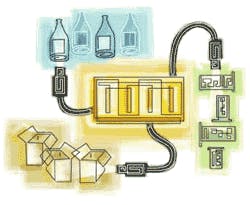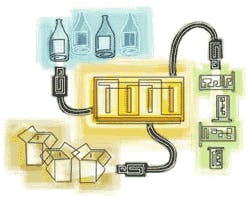Automated control systems set manufacturing pace
George Kotelly, Editor in Chief
[email protected]
At the recent 2003 Technology Connection Symposium for Editors, sponsored by Omron Electronics LLC (Schaumburg, IL, USA; www.info.omron.com), chief executive officer Frank Newburn, in a keynote address, anticipated an overall flat market for automation products through April 2004. On the other hand, he did see opportunities in some high-growth application areas and in some nonmanufacturing automation applications. Omron Electronics is now doing $300 million in sales, mostly in industrial automation and electronic components.
Newburn projects lower than average growth in the semiconductor market, a slight increase in the domestic automation market, and average growth in the food and beverage inspection market. He says, "Manufacturers continue to be cautious regarding capital investments in new equipment. This trend is expected to continue into the first quarter of 2004. Many companies are still running below capacity levels, so new equipment purchases are being delayed.
"We are seeing above-average growth in several automation areas, such as in-line inspection, machine safety, and component traceability. Not surprisingly, these bright spots coincide with the trend to quickly adapt lean manufacturing approaches and to squeeze costs out of manufacturing.
"Manufacturing is the last frontier for cost reduction for most companies," Newburn continues. "Low initial investments in quality improvements and electronic data-tracking systems have proven to provide quick returns and long-term cost savings," he says.
In component traceability, Omron has found that cradle-to-grave tracking has recently become a fast-growing market trend. In particular, manufacturers in the automotive and health-care product industries are tracking nearly every part through fabrication and assembly to improve process efficiency and to limit liability.
David Quebbemann, Omron Electronics marketing and operations manager, discussed how Omron is emphasizing "total cost of ownership" rather than achieving the lowest possible product-making cost. He maintains that the company is integrating ease of use, flexibility, quality, technology, stability, and support for its "Quality First" product-development designs. For example, the company is making automation products that support open network technologies, such as Ethernet; rely on just one hardware, software, and cable structure; and offer long-term life cycles.
Mark Lewis, Omron Electronics corporate communications manager, chaired a panel session, "Squeezing the costs out of manufacturing," that included representatives from three manufacturers. They described how they were able to improve their manufacturing processes via automation products and controls.
Dennis Klotter, assembly engineering manager at Ogihara America Corp. (Birmingham, AL, USA; www.ogihara.com), spoke on how his company has automated the stamping and subassembly processing of structural automotive body panels. He explained the attained financial, time, and product-development benefits of the company's automated "score card system." This system tracks initial flow control, real-time data collection, root cause analysis tools, and the target assembly goals of all product-manufacturing assembly processes.
Eric Culberson, senior project engineer at Shell Solar Industries (Camarillo, CA, USA; www.shell.com), which makes low-cost solar photovoltaic cells, proclaimed, "Automate, automate, and automate." He cited substantial labor reductions, 100% increases in throughput, and real-time process control and traceability obtained by automating two-cell assembly operations.
Joseph A. Jansen, controls technician, at Kemet Electronics Corp. (Greenville, SC, USA; www.kemet.com), a global supplier of capacitors, detailed his company's plan for saving manufacturing expenses through automation. This plan involves training programs for raising engineering and technology staff skills, frequent progressive testing to detect bad components, improving product quality, implementing leading-edge tools and technologies, and supporting research and development.
New products unveiled
Several new Omron automation-type products were unveiled at the symposium. The CS1D duplex mid-sized programmable logic controller (PLC) adds redundancy features to the existing simplex CS1 PLC line. Dual redundant power supplies, CPUs, and network and hot-swappable I/O modules can be switched, removed, or replaced without interrupting unit operation.
The CS1W-MCH71 motion controller provides fast and accurate control of up to 30 physical axes of motion simultaneously and runs as many as eight concurrent programs. The V530-R160E and -R160EP (different I/Os) 2-D code readers consist mainly of two F150 cameras, controller, memory cards, console, and monitor. They can read pin-stamped, laser-etched, and printed marks on automotive components at any rotational angle on any surface at camera slant angles of up to 60°.
Mark Sippel, Omron vision product marketing manager, offered some preliminary specifications of the company's soon-to-be-released F210 industrial machine-vision sensor. Key specifications include 512 × 484-pixel resolution, two camera connections, RS-232C/422A serial communications, 13 inputs, 22 outputs, one memory card slot, one console port, one monitor port, and two strobe interface channels. Available easy-to-load algorithms include edge code positioning, Quest character recognition, edge code defect inspection, and fine matching. Targeted applications cover product sorting, detection/counting, part gauging, electronic device inspection, OCR and packaging inspections, and robotic tool guidance.
Systems integration
At another recent conference—Siemens Dematic Talks, Americas, 2003, held in Dallas, TX, USA—Siemens Dematic AG(Nuremburg,Germany; www.siemens.com) focused on how manufacturers can reduce their product life-cycle costs by incorporating automated control systems. The company offers a range of integrated production and logistics platforms for materials-handling automation, electronics assembly, and postal automation applications. By offering complete automated control over the integration of mechanical systems and intelligent information technology from a single source, Siemens aims at delivering low-cost systems with increased mean time to failure, reduced mean time to repair, and installed predictive failure tools.
In one of several executive keynote addresses, Pete Metros, a member of the Siemens Demantic management board, said, "Given the increasingly complex tasks involved in supply chain [business process] optimization, manufacturers are turning toward integrated solutions and Siemens Dematic has aligned itself to meet this need." He commented that in 2002 Siemens Dematic posted $2.9 billion in sales, with the Americas accruing 53%, Europe 37%, and Asia Pacific 10%.
A core element of this systems approach is to seamlessly integrate all automation processes from mechanical components to complete information technology platforms. For example, in electronics manufacturing, Siemens Dematic Electronics Assembly Systems (EAS; Norcross, GA, USA; www.siemens.com) offers users an integrated platform solution for supply chain optimization. Jeff Timms, Siemens EAS sales and service manager for the Americas, says, "Supply-chain optimization is a major lever in the electronics industry to improve productivity and increase manufacturing flexibility at the same time."
To meet surging airport-screening demands, Siemens Dematic Material Handling Automation (MHA; Grand Rapids, MI, USA; www.siemens.com) is involved in projects to improve the speed and convenience of automated baggage-handling systems. Prashant Ranade, MHA president, pointed out that today's customers are intent on removing nonvalued activity from their supply chain operation. They are demanding speed and flexibility from automated control products to keep materials-handling costs down and to improve quality. For example, in a recent warehouse-supplier application, an installed Siemens Dematic automated control system cut module-picking errors by 98% while increasing materials-handling productivity by 120%.
Market activities
The worldwide market for distributed control systems (DCS) including hardware, software, and services is expected to grow from $9.1 billion in 2002 to more than $10.3 billion in 2007. In a report by Larry O'Brien, director of research at ARC Advisory Group (Dedham, MA, USA: www.arcweb.com), this market declined between 2001 and 2002 by over 2%. The persistent global economic weakness with limited capital spending in the process industries is expected to result in the DCS market growing less than 1% between 2002 and 2003. However, growth through 2007 is forecast to improve so that the average annual rate for the period is 2.5%.
Demand-side indicators for manufacturing remain weak in both North America and Europe. According to the report, US industrial production declined by 0.5% and US manufacturing output decreased by 0.2% in March 2003. Capacity utilization remains below 80%, and capacity utilization decreased to 74.8% in the first quarter of 2003, compared to the same period in 2002. Europe's manufacturing capacity utilization remains essentially flat. However, industrial production in Europe was on the increase after flat results in the fourth quarter of 2002.
O'Brien says that at some point users must choose to upgrade their existing control systems or migrate to new ones. Sometimes, upgrades are not possible because the system has been phased out altogether or the installed system is based on outdated architecture. Migration to a new control system is expected to occur when the old system keeps users from taking advantage of a new business opportunity or presents the threat of unscheduled downtime.
Currently, reduced capital spending, a depressed economy, and mining existing assets mean that most control systems sold are for replacement applications.

